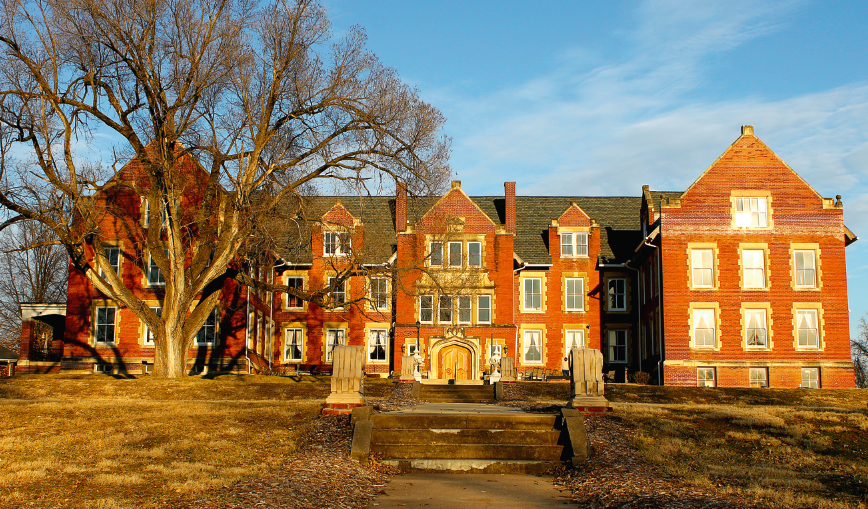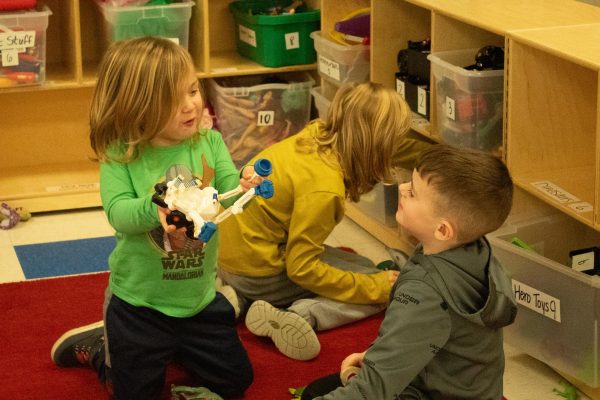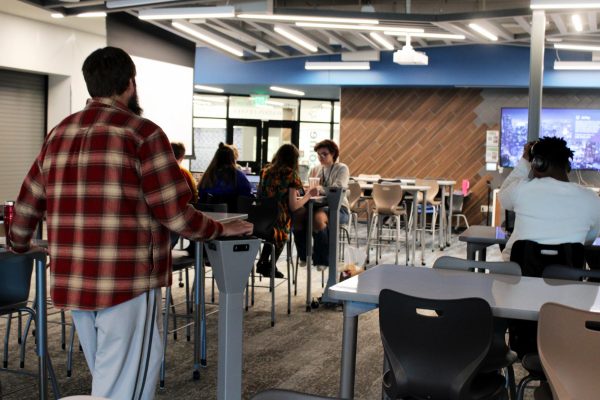The Good Old Days
Even though the town of Liberty continues to change and expand, the community manages to keep a small town attitude while still acknowledging the history that comes with it. Besides the very well known Jessie James Jail, there are a few other historical places around Liberty that still make a difference in our community today.
Clay County Museum
The historic Liberty Square is well known for having many local owned stores, banks, and businesses that have been there since the late 19th Century, including the the Clay County Museum.
“This place has always been a drugstore/general store, until the museum purchased it in 1965,” Museum Manager Jana Becker said. “We still have the original floor from the 1870s remodel that they did and the original cabinetry from the 1870s.”
Becker also mentions that the museum features busts of Noah Webster and William Shakespeare, which were used at the time to inspire those who entered the store.
“One story about what caused the remodel in the 1870s is that they used to have a keg of gunpowder that sat in the middle of the store,” Becker said. “Somebody came in sat on it and lit his pipe and the thing blew up and blew out the whole front end of the building. Of course, it was fatal for him, but some people said he did it on purpose.”
Mace Shoe Repair
Mace Shoe Repair is another family business on the Liberty Square owned by Daryl Mace whose father started the store as a shoe repair store and taxi service. When Mace’s father started the business, he did not know how to repair shoes, so he hired a man from Kansas City to teach him and work for him. He and his wife Sandy also mentioned that this community never had any serious issues or crimes that other cities had to deal with due to the cities separation from that mentality
“Something I’m proud of as far as this community [when I was growing up] is we were all educated the same. Races were not a problem here. We didn’t have all the riots that started in Kansas City,” Mrs. Mace said.
“Nothing ever happened here, a police man told me one time when I was a young man, it like Liberty’s just had a protective bubble over it for years,” Mr. Mace said.
Liberty Community Center
Though the Community Center was established in the late 1980s it has still had big impacts on the community.
“We were one of, if not the first, facilities of this kind built by a municipality in the Northland area,” Community Center Manager Donna Kay Taylor said.
According to Taylor, the center is also unique due to its cooperative use agreements with the school district. On top of providing exercise facilities, meeting places and classes for health or practical skills, the center is used for both the swim and dive teams for Liberty and Liberty North High school, as well as a performance and assembly space for the middle school.
“We’re kind of a model for a lot of cities and school districts,” Taylor said. “Nobody shares in any kind of staffing, nobody has to pay staffing costs on either side, nobody pays for any kind of maintenance keep up or anything. There’s all kinds of ways you can develop a cooperative-use agreement but this one works incredibly well for both parties.”
Liberty High School 1970s — Chris McMenemy
On the search to learn more about Liberty we met by Chris McMenemy, William Jewell College, LHS alumni, William Jewell College, and retired LHS teacher.
“I graduated 1974, and the first graduating class from Liberty was 1973, so I was there the first year it opened and then of course the second year. It looks the same in a lot of ways and I got to look inside it a few years back after they had done all the remodeling,” McMenemy said. “It was built in the 70s when they wanted flexibility, so the rooms didn’t really have walls then. They had these curtain things you push back and forth but they wouldn’t shut all the way because there was no hallway and there were three rooms.”
McMenemy continued her love for teaching and knowledge at William Jewell College. “I went to William Jewell for four years. I came back to teach at Liberty High School. I came back as an art teacher and I did the yearbook,” McMenemy said.
“At some point we actually had a cable news show but they had a little place right across over there on the other side of the square. That’s where we went in and did our little news show,” McMenemy said.
McMenemy said many changes have taken place over the years in schools from her teaching standpoint.
“When we first started, we had no computers or anything like that and about two or three years into it we first started typing our stories and then the Liberty Shopper would fix it all up for us and print out all these strips for us [for the newspaper],” she said “We’d paste it down and when I was in there one day and Dale Garrison [printer of the school paper] came in. He goes, ‘Chris! Chris! Come here, I have something to show you.’ He had a mac and he goes, ‘Okay, we’re starting to do our newspaper on the Mac,’ and I’m like, ‘Oh my gosh!’ He showed me desktop publishing. I went to my principal and said, ‘I want to tell you something.’ He let me buy it and I couldn’t believe it.”
“We got three of the little tiny Macs. They’re in museums now with the little tiny screen one piece and a laser printer. The laser printer cost $6,000 or some ungodly amount because now they cost $200 or $300,” McMenemy said.
“So we had our little computers and we started doing the newspaper and yearbook and eventually we did it all so you could basically print out in sections because we didn’t have anything that could print big enough. In fact, one of the Bell newspapers was 8½ by 11 so that we could do it all on one sheet because we were always changing it up. The year we did our Yearbook on desktop publishing was the year before there had been four high schools in the whole nation to use desktop publishing. I don’t know how many there were at the time we had did it but we were one of the first.”
WIlliam Jewell College
William Jewell is the beloved college in our town, but where would we be without it? Ruth Bax Edward, EdD RN at Jewell has been working there since 1973. Throughout these past years she has seen the school grow into the successful college it is today and knows the history and hauntings of this historical school.
There are many stories of how the school is haunted. “They closed the school briefly during the war but during the Civil War they had horses downstairs, a hospital on the top and they had soldiers living on the middle floors.
“Every year when it’s Halloween, people come to “feel” the ghosts because they had the hospital that people died in upstairs,” Edward said.
The students also take part in the ghost lore every year.
“We have a cemetery just on the other side of campus and people do ghost walks and that kind of stuff there because it’s a cemetery.” she said. “They had somebody from the people that are interested in ghosts come and they sat in Jewell Hall for days listening for ghosts. Somebody said they felt a presence.”
Even though the school is changing, Edward said that the history and character of this school hasn’t been lost. “This campus really captures the history. We still have all our old buildings but have redecorated them and renovated the insides,” Edward said. “I think we’ve kind of kept the character. The buildings that have been redone all have historic character to them. Some have taken on more of the black and red colors of the college with the furniture that we get. They are sort of modern but they always have a little bit of history with them. It varies a little bit from president to president.”
Edward had a first hand experience of being somewhat segregated because of her religion.
“When we started out, William Jewell was a Christian and a Baptist. So this was a Baptist school for a long time. I’m Catholic and when I started here I didn’t realize there was that much of a division between the religions. I just came here because I liked the people, I liked what they believed in with nursing.”
Being a student Edward didn’t think much of her religious preference until it threatened her chance in school.
“I was getting ready to get married at the time and they asked me where I was getting married and I told them the Episcopal church down on Warnol Road and so they didn’t realize I was Catholic. We got our orientation stuff and were having a picnic on the Quad and I was talking to a couple of real conservative alums and the president and several people and they said something about religion and I said I was Catholic and I could see they just melted. And then they had to do some thinking to see if they would let me stay.”
Since then the college has grown to not limit the applications to the school to only Christians and Baptists.
“Now we are very integrated. It is very different. Now we look for people who make us unique and different and have an opportunity for all of us to get to know each other. And we are no longer strictly a Baptist college, we are an independent liberal arts college; it is an interesting place to be. A nice new college would be fun too but this is just kind of you live that experience of going to college, living in the dorm, and the students really know everyone because it is small.” Edward said.
The connection to the town hasn’t been lost throughout the years Edward explains. “We do a lot with the Liberty Community. We call it “Town and Gown”.They do things for us and we do things for them. A lot of our faculty members have been city councilmen, and one of our faculty’s husband was mayor for awhile. One of our alums has been mayor for awhile also,” Edward said.





